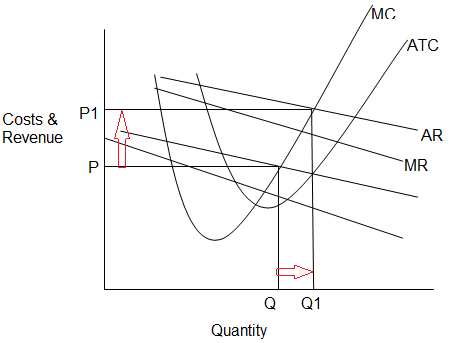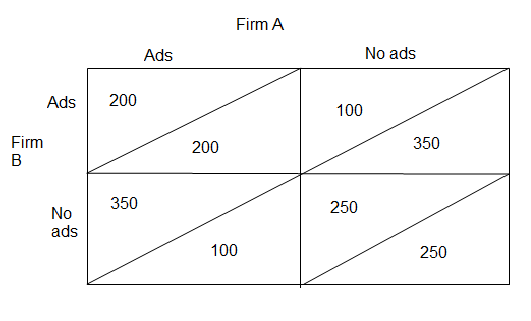Role of Advertising in Monopolistic Competition
Monopolistic competition is characterized by multiple firms that sell differentiated products. Advertising is a technique used by firms in monopolistic competition to create product differentiation. The goal of product differentiation and advertising in monopolistic competition is to make sure the the market is under control, and as a result, charge a higher price. Excessive advertising will serve to inform consumers about the physical difference in the product, and the perceived difference will lead to increased product differentiation.
If advertising in the long run convinces customers that the product is superior to the competitor’s, then the firm would charge a higher price (Arnold 241).

What role does advertising play for monopolistically competitive firms? Advertising will increase demand and reduce demand elasticity. As seen from the short-run equilibrium graph, Q gives the current profit-maximizing output at a price P. Therefore, advertising will increase the quantities of the product the consumers are willing to purchase, leading to a shift or a move in the demand curve to a higher level. The new demand curve will correspond to higher levels of quantity demanded and the prices given by Q1 and P1 (Arnold 245). As such, the role of advertising in monopolistic competition is monumental.
In monopolistic competition, the firm faces a comparatively elastic demand, and this limits the prices that can be charged on the product. To reduce demand elasticity, the demand curve will be relatively steeper, implying that consumers are likely to change their quantity demanded as a result of a change in price. As illustrated in the diagram, the firm can now charge a slightly higher price P1 for the same quantity, and this means the firm can collect more revenues for the same quantity Q sold at a profit-maximizing level of output (McConnell and Brue 494).
However, a monopolistically competitive firm cannot maximize profit when faced with inelastic demand because the marginal revenue (MR) is negative, implying that the marginal cost (MC) would be negative. Such a situation is not possible, where marginal revenue (MR) and marginal cost (MC) are both negative (Arnold 246). Excessive advertising could lead to inelastic demand, and the firm will have to increase the price to make demand elastic because profit is not maximized when demand is inelastic. (McConnell and Brue 489).
Advertising is expensive, and the firm will keep on advertising as long as the revenues generated from advertising are more than the cost of advertising. Monopolistic competitors advertise because the demand may increase and become inelastic, and, on the other hand, the marginal cost (MC) and average cost (AC) are likely to rise at the same time.
Advertising in monopolistic competition is excessive, and as long as revenues per product are more in comparison to an increase in average cost per product, it may not result in loses. One of the characteristics of monopolistic competition is relatively easy entry. Firms in a monopolistic competition market will use advertising to maintain their profits because advertising affects the products of the firm by increasing its demand.
Advertising in Oligopoly
The oligopolists can increase their market share through advertising, and they compete based on advertising rather than on pricing (McConnell and Brue 492). Excessive advertising by the Oligopolist is used as a barrier against the entry of other firms.
It is also used to inform consumers of new products in the market. Oligopoly advertising also leads to increased output pushing down the average total cost (ATC) curve towards the productive efficiency point, where the average total cost (ATC) is minimum. Advertising may also lead to manipulation as opposed to informing consumers.

Unique feature of oligopoly is mutual interdependence. To understand the interdependence behavior of oligopolistic firms, the technique of game theory is used as illustrated in the diagram, and it shows that the two firms are better off colluding than competing. At the top left shows that both firms A and B could earn 200 dollars profit each if they choose to advertise. At the right lower quadrant, the two firms can receive 250 dollars each if they both decide not to promote because there are no costs for advertising (McConnell and Brue 496).
At the lower-left quadrant, firm B decides to advertise while firm A does not advertise and, therefore, firm B will earn 350 dollars in profits, and firm A earns 100 dollars in profits. This is because advertisement attracts customers from firm A to firm B.
At the top right quadrant firm B does not advertise while firm A decides to advertise, therefore; firm A receives 350 dollars profits while firm B receives 100 dollars in profits because customers are attracted away from firm B. On the other hand, if the two firms chose to collude to advertise they would each receive 250 dollars profits.
In an oligopoly, there are few dominant players in the market, and each cannot fully influence the market independently unless they collude to influence and affect the price and demand. The use of advertising by oligopolists increases both market share and total demand.
In an attempt to gain a more significant market share, an Oligopolist will engage in fierce advertising competition trying to outdo each other. (McConnell and Brue 494). This scenario makes advertising in the oligopolistic markets to be extremely high. It is difficult to tell if advertising leads to improved consumer benefits and efficiency. However, if advertising results in more sales and increased output, this could lead to the efficiency of the firm.
Monopolistic Competition – Advertising Role: Essay Conclusion
It is costly to advertise and may lead to improved efficiency if costs are less than the benefits from sales. Advertising in monopolistic competition and oligopoly may have no direct relationship with the benefits to the consumer. However, if increased sales arising from advertisement leads to reduced prices, then customers will enjoy some benefits (McConnell and Brue 487).
Works Cited
Arnold, Roger A. Micro Economics. 10th ed. Washington, DC: Cengage Learning, 2010. Print.
McConnell, Campbell R. and Stanley L. Brue. Economics: Principles, Problems, and Policies. New York, NY: McGraw-Hill/Irwin, 2005. Print.